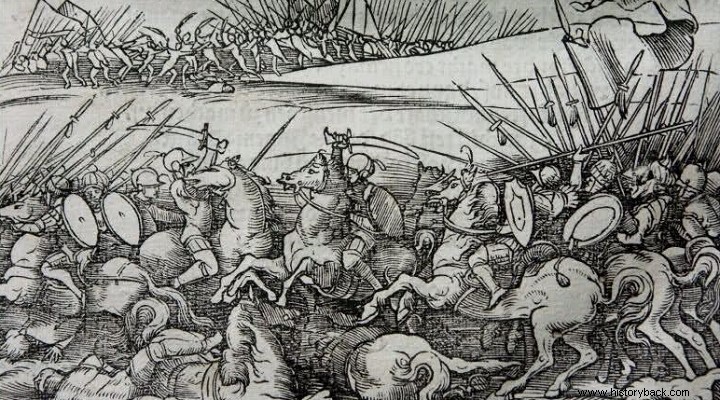
The battle of Torviol was fought between the forces of Georgios Kastriotis and the Ottomans. George was the son of Ioannis Kastriotis. The debate about his origin still continues with Albanians considering him their national hero.
Kastriotis had been given as a hostage to the Turks and was renamed "Skenderbey" (Bey Alexander) for his bravery. He managed to escape from the Turks, went to Albania and started a war against the Ottomans, alongside the Hungarian Ioannis Uniadis and Constantine Palaiologos.
Sultan Murat reacted immediately and ordered his general Ali Pasha to crush the rebels, leading a strong army of 25,000 – 40,000 men, depending on the source. Ali Pasha started from Skopje and moved towards today's Albania.
Against him, Kastriotis had 15,000 men – 8,000 mainly light cavalry (Soldiers) and 7,000 light, mostly infantry. After the celebration of the divine service, Kastriotis moved and deployed his forces in the plain of Torviol near Episkopi, not far from the borders of today's Albania with the state of Skopje.
Kastriotis had chosen the field carefully. The narrow plain had an opening of only 11 km and a depth of 5 km. It was surrounded by hills and forests. In other words, it was the ideal field of action for light troops, such as those it possessed.
Kastriotis assigned 3,000 men to his nephew Amesi, known as Hamza Kastriotis, and to four more of his commanders, with the order to set up an ambush deploying them in the forests on either side of the main resistance site. The aim was that when the Turks would attack his forces head on, the men in the ambush would fall on their flanks.
In the meantime, the Turkish force arrived in the area and camped opposite the bulk of Kastriotis' army. All night before the battle the Turks were making noise around large fires that had been lit. There was silence in the Christian camp.
The battle
On the morning of June 29, 1444, Kastriotis was expecting the Turkish attack having arranged 9,000 men in the front line and 3,000 as a reserve. The front-line divisions were deployed in three "brigades" of 3,000 men each, with the central echelon deeper than the others. Thus the Christian line presented a semicircle shape.
Kastriotis' men were positioned at the foot of a hill. Their aim was to act as a decoy and lure the Turks into an attack. Immediately afterwards they would retreat to the hill so that the trap could be completed.
The "brigades" of the two wings had 1,500 infantry, mainly archers, and as many horsemen. The central "brigade" was gradually developed with 1,000 light cavalry in the first echelon and foot archers behind. Behind the archers came heavier armed infantry.
When everything was ready, Kastriotis was waiting for the enemy. Ali Pasha moved against him. A Turkish cavalry charge attacked the Christian outposts in the center but was repulsed. Kastriotis forbade his men to pursue the Turks for fear of a trap. This was repeated on the Christian left. In the meantime the Turkish tumor had approached.
Then Kastriotis gave the signal. The "brigades" fell upon the Turks pinning them head on in the narrow field where their numerical superiority was no advantage. At the critical moment, Kastriotis' men in reserve rushed against the Turkish flanks and south.
The Turks fled in panic. Despite this, the Turkish center continued to resist until it was surrounded and the reserve units of Kastriotis were also thrown into the battle. A savage massacre ensued. Thousands fell and those who survived fled in disorder.
Turkish losses were overwhelming. The dead, depending on the source, are estimated at 8,000 – 22,000 men with the second number considered more likely. Another 2,000 – 4,000 Turks were captured.
The victory caused admiration throughout the Christian world. Kastriotis continued to fight the Turks heroically until his death.
